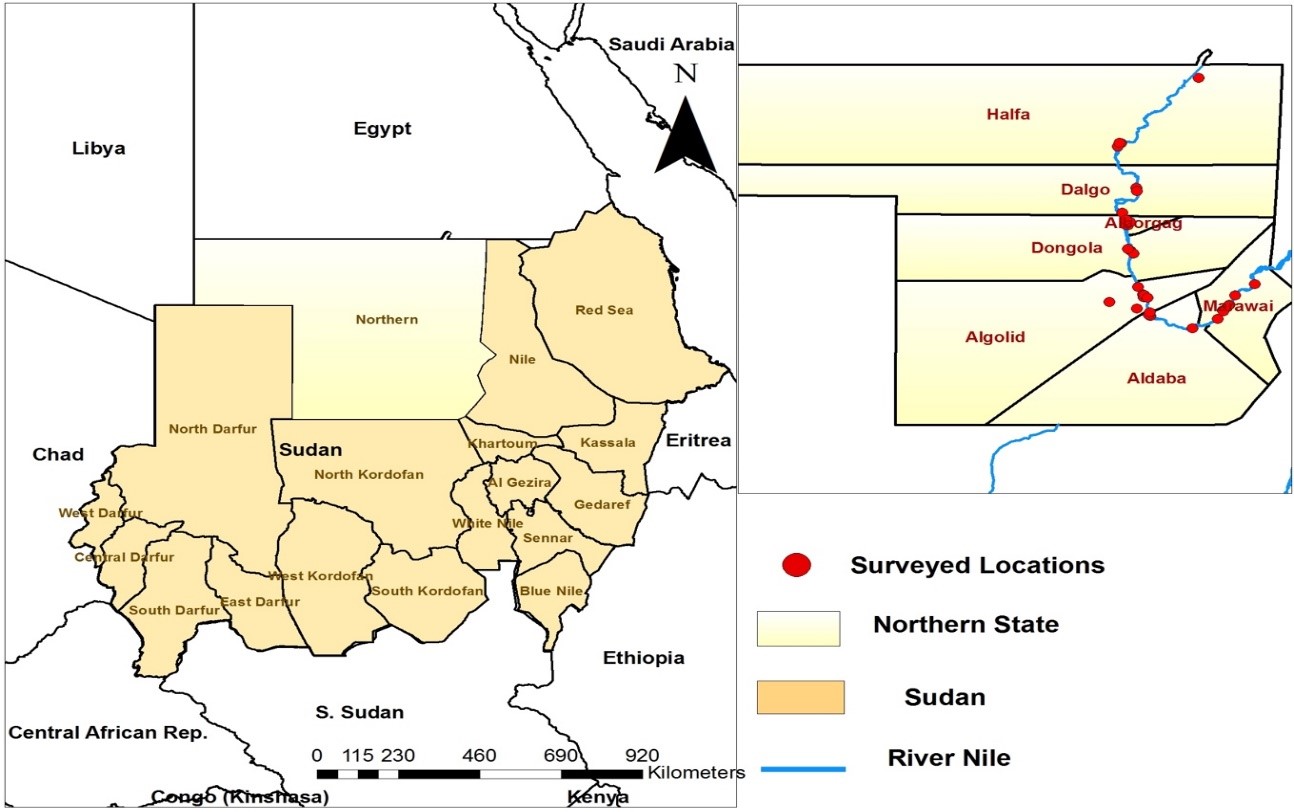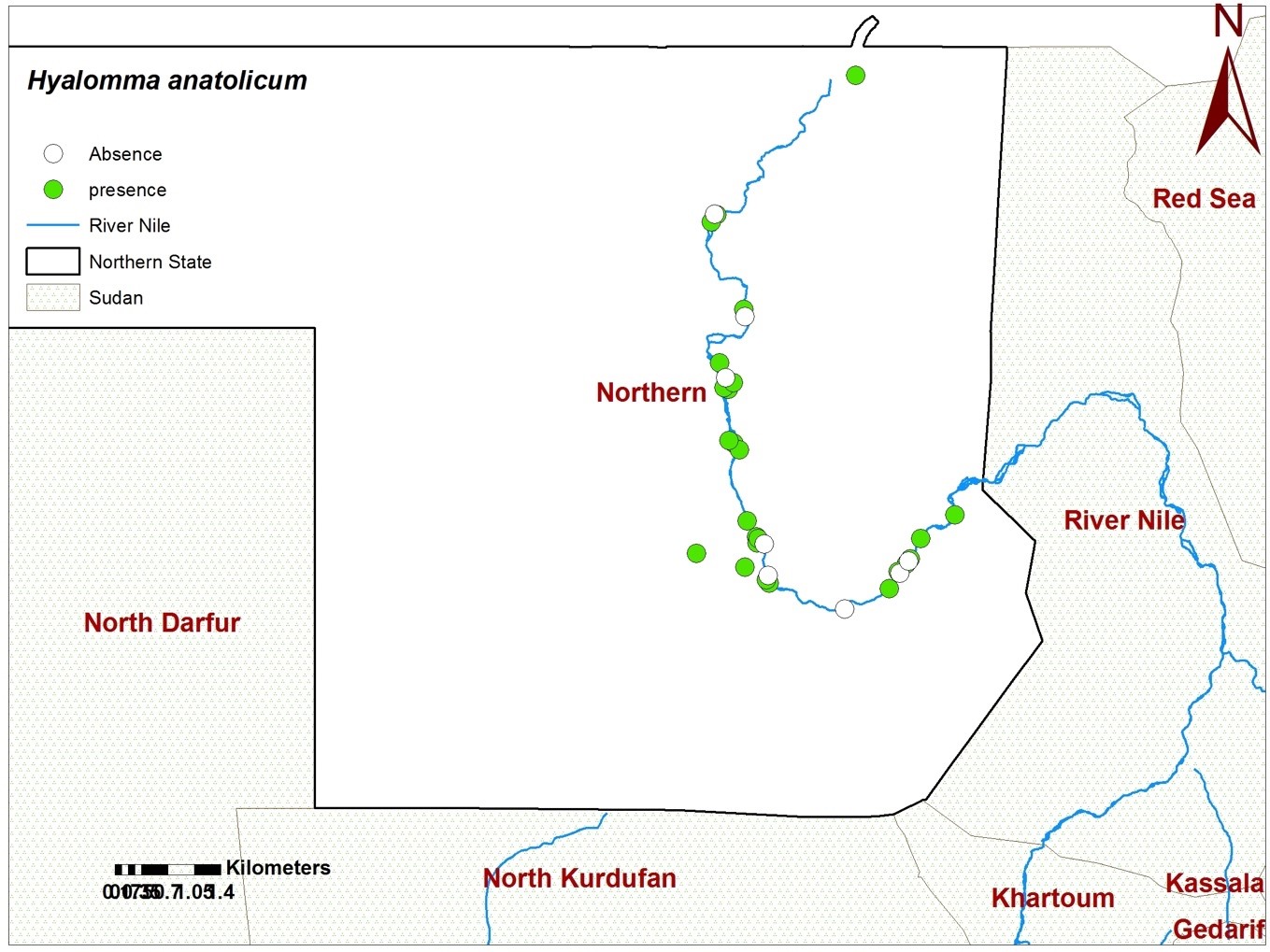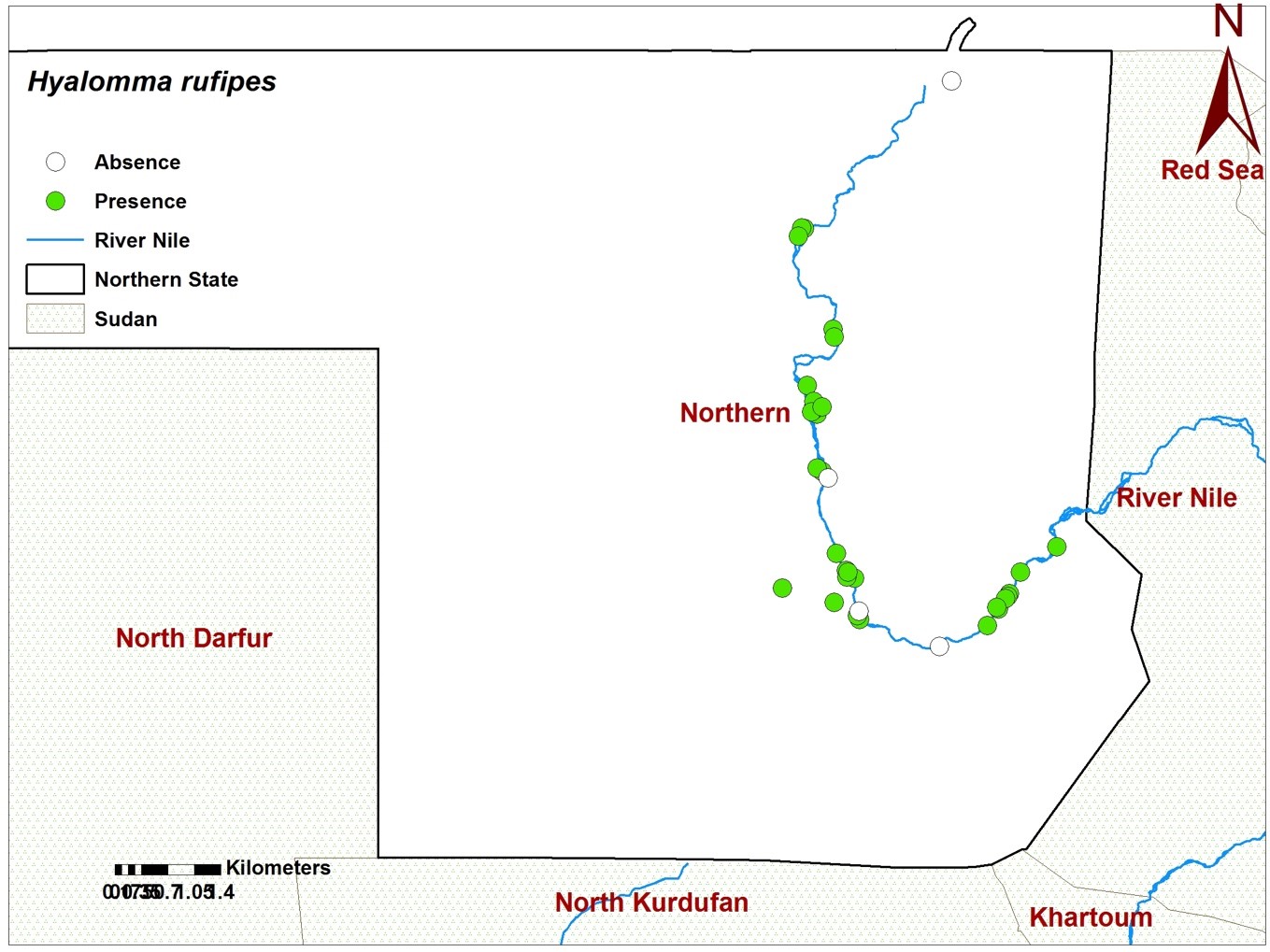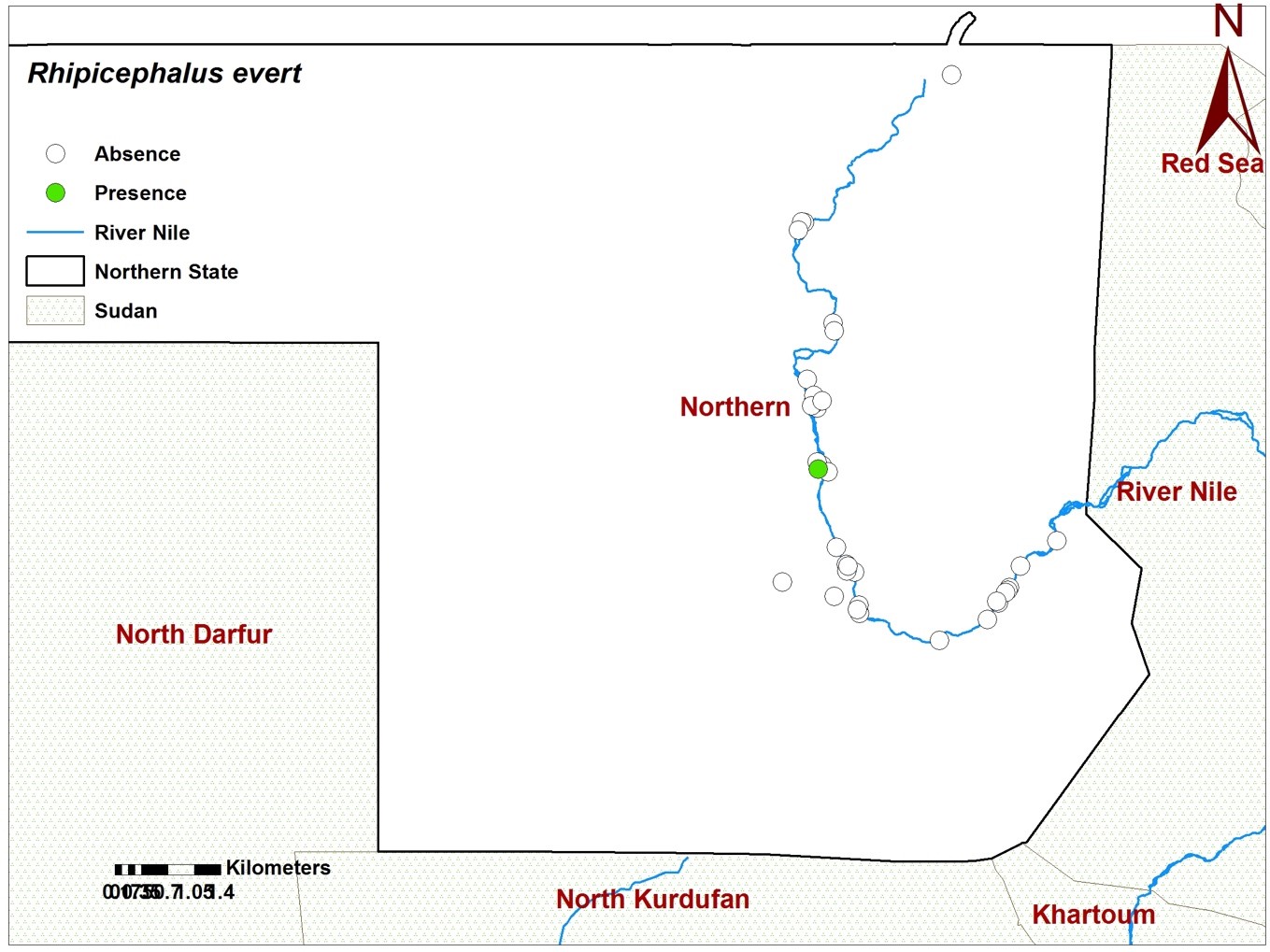Indexing & Abstracting
Full Text
Research ArticleDOI Number : 10.36811/jvsr.2019.110005Article Views : 33Article Downloads : 33
Baseline survey of Ixodid Ticks Infesting Cattle in Northern State, Sudan
Mohamed Toum Elhaj1, Khalid Mohammed Taha2, Ahmed El Ghali1, Shawgi Mohammed Hassan3, Diaeldin Ahmed Salih1*, Jabbar Ahmed4, Peter-Henning Clausen4, and Abdel Rahim Mohammed EL Hussein1
1Central Veterinary Research Laboratory, P.O. Box 8067, Khartoum, Sudan
2Atbara Veterinary Research Laboratory, P. O. Box 121, Atbara, Sudan
3Faculty of Veterinary Medicine, University of Khartoum, P. O. Box 32, Khartoum North, Sudan
4Institute for Parasitology and Tropical Veterinary Medicine, Freie Universität Berlin, Robert-von-Ostertag-Str. 7-13, 14163, Berlin, Germany
*Corresponding Author: Diaeldin A Salih, Central Veterinary Research Laboratory, P.O. Box 8067, Khartoum, Sudan, Tel: +249-83467256; Email: diaeldin2000@hotmail.com
Article Information
Aritcle Type: Research Article
Citation: Mohamed Toum Elhaj, Khalid Mohammed Taha, Ahmed El Ghali, et al. 2019. Baseline survey of Ixodid Ticks Infesting Cattle in Northern State, Sudan. J Veterina Sci Res. 1: 37-46.
Copyright: This is an open-access article distributed under the terms of the Creative Commons Attribution License, which permits unrestricted use, distribution, and reproduction in any medium, provided the original author and source are credited. Copyright © 2019; Mohamed Toum Elhaj
Publication history:
Received date: 26 September, 2019Accepted date: 03 October, 2019
Published date: 05 October, 2019
Abstract
Background and objective: Ixodid ticks are serious obstacle to development and utilization of animal resource in tropical countries like Sudan. Over 70 species of tick are prevalent in the Sudan in diverse ecological zones. The aim of this study was to provide a baseline data on tick species infesting cattle in the Northern State, Sudan as a prerequisite to design tick control policy in the state as well as the whole country.
Materials and Methods: This study was conducted in April 2017 and included seven provinces of the state. Total body tick collection (n=1,098) was carried out from 365 heads of cattle. Tick identification to the genus and species level was carried out as well as statistical analysis using two-way ANOVA.
Results: Nine tick species of two genera, Hyalomma and Rhipicephalus, were identified. The genus Hyalomma represented 82% of the collected ticks. Hyalomma rufipes was the most common tick species (48.5%) followed by Rhipicephalus praetextatus (14.9%), H. anatolicum (14.4%), H. excavatum (12.8%), H. dromedarii and R. sanguineus (3.4% each), H. impeltatum (2.2%), H. marginatum (0.46%) and the least prevalent tick species was R. evertsi evertsi (0.09%). The prevalence of tick infestation significantly varied within the age groups for H. anatolicum, H. rufipes and H. excavatum. The mean tick infestation was found to be independent on breed and sex of the animals.
Conclusion: It is concluded that there were nine ticks species distributed in the State. Among these species is H. anatolicum, which is the vector of two vital diseases, bovine tropical theileriosis and malignant ovine theileriosis. Thus, tick control strategy, and creation of awareness among animal breeders on the problem associated with tick infestation are recommended.
Introduction
Ticks are destructive and obligatory blood sucking parasites, found in most if not all the countries of the world. They parasitize reptiles, birds and mammals [1]. Ticks cause blood loss, inflammation and irritation of the skin, stimulate hypersensitive allergic reactions; and they may cause a toxic reaction in the host, complicated by paralysis (called “tick paralysis”). They are important vectors of diseases affecting both humans and animals [2].
This is the second study on the distribution of tick infesting livestock in the Northern State of Sudan since the 1950s. The first study on ticks in the Northern State of the Sudan was done by Hoogstraal in 1956 who identified 11 tick species: Hyalomma excavatum, H. dromedarii, H. impeltatum, H. rufipes, H. marginatum, H. impressum, H. detritum, H. truncatum, Rhipicephalus evertsi evertsi, R. sanguineus and R. pretextatus in the Northern Provinces (currently River Nile and Northern States). All subsequent tick surveys were performed in other areas of Sudan. Eleven tick species infesting cattle in River Nile, Central, Western and Eastern parts of the Sudan were identified [3]. These were Amblyomma lepidum, A. variegatum, Hyalomma anatolicum, H. dromedarii, H. impeltatum, H. truncatum, H. rufipes, Rhipicephalus decoloratus, R. evertsi evertsi, Rhipicephalus sanguineus group and R. praetextatus. H. dromedarii, H. impeltatum, H. anatolicum, H. truncatum, H. rufipes, R. praetextatus and R. sanguineus were identified in camel in River Nile State [4]. In Sennar State Amblyomma lepidum, H. anatolicum, H. truncatum, R. decoloratus, R. camicasi, R. evertsi evertsi, R. guilhoni and R. muhsamae were identified [5].
The most significant cattle tick in the country (above 10 latitude) is Hyalomma anatolicum, the vector of Theileria annulata and T. lestoquardi the causatives of tropical theileriosis in cattle and malignant ovine theileriosis in sheep, respectively [6-8]. Ticks of Amblyomma variegatum and A. lepidum transmit Ehrlichia ruminantium, among sheep, goats and cattle [9,10], while Rhipicephalus decoloratus and R. annulatus are the main vectors of bovine babesiosis [11]. This study was conducted with the objective of elucidating tick species infesting cattle in Northern State of the Sudan.
Materials and Methods
Study area
The Northern State shares boundaries with four Sudanese states (Khartoum, River Nile State, North Kordofan, and North Darfur State) in addition to Egypt and Libya. The total livestock population of Sudan in the year 2014 is estimated to be about 105.8 million: 30.2 million cattle, 39.8 million sheep, 31.0 million goats, and 4.8 million camels. Cattle population in the Northern State in the same year was estimated to be 256,624 [12]. This study was conducted in seven provinces of the Northern State: Halfa, Dalgo, Borgig, Dongola, Golid, Deba, and Marawi (Figure 1).
Tick collection
The survey was conducted during April 2017. The surveyed infested animals were mostly present in the agricultural areas of the River Nile banks in both east and west side of the river, in addition to the islands. A total body tick collection was made on 365 infested cattle. The collected ticks were transferred into a glass bottle containing 70% ethyl alcohol for preservation and brought to the laboratory for identification. Information such as date and place of collection, age, sex and breed of the host were recorded at the time of collection [13].
Tick identification
The ticks were identified morphologically under a dissecting microscope at Department of Entomology and Ticks, Central Veterinary Research Laboratory, Khartoum, Sudan [12,14].
Statistical analysis
Data collected on ticks were subjected to an appropriate general linear model (GLM) procedure using the Statistical Analysis System (SAS) package. These data include the number of ticks collected, the county where collection was carried out, as well as breed, age groups and sex of cattle from which ticks was collected. The SAS was used to perform two-way analysis of variance (ANOVA) while mean separations were performed using the Ryan-Einot-Gabriel-Welsch (REGW) multiple range test [15].

Figure 1: Study area showing map of Sudan and in the right Northern State, with sample collection sites.
Results
Prevalence of tick species in the Northern State
A total of 1,098 ticks were collected from the infested cattle. Generally, two tick genera, Hyalomma and Rhipicephalus, and nine species were identified from the seven study areas (Figure 2-4). The genus Hyalomma (82%) was more prevalent than the genus Rhipicephalus (18%) in the State. Hyalomma rufipes was the most common tick species (48.5%) followed by R. praetextatus (14.9%), H. anatolicum (14.4%), H. excavatum, (12.8%), H. dromedarii and R. sanguineus (3.4% for each), H. impeltatum (2.2%), H. marginatum (0.46%) and the least prevalent tick species identified was R. evertsi evertsi (0.09%) (Table 1).

Figure 2: Distribution of Hyalomma anatolicum in Northern State, Sudan during April 2019.

Figure 3: Distribution of Hyalomma rufipes in Northern State, Sudan during April 2019.

Figure 4: Distribution of Rhipicephalus evertsi in Northern State, Sudan during April 2019.
Distribution of tick species in the seven provinces
The mean total numbers of ticks per head of cattle at the different location are summarized in Table 2. The highest mean (4.08±0.38) of the number of ticks identified was recorded at Dongola Province, while the lowest mean (1.70±0.17) was recorded at Deba (Table 2). The mean number of H. anatolicum (1.05±0.21) was significantly different in Dongola compared to all other provinces. The same result was reported for H. excavatum (1.58±0.28) and H. impeltatum (Table 2). While the mean number of H. rufipes (2.84±0.37) was significantly different in Dalgo. On the other hand, no significant difference was observed in the mean number of Hyalomma dromedarii and Rhipicephalus sanguineus in seven provinces (Table 2).
The mean tick infestation significantly varied with the age of the animals for H. anatolicum, H. rufipes and H. excavatum. The young calves (<1 years) was found to carry significant higher number of H. anatolicum (0.65±0.12) and H. excavatum (0.65±0.20) than the older cattle (1-3 years and > 3years) (Table 3). With regards to H. rufipes, the highest significant number of ticks (1.65±0.13) was report in the older cattle of >3 years old (Table 3). On the other hand, breed and sex of cattle were found to have no significant effect on the mean tick infestation (Table 3).
|
Table 1: Distribution of tick species in the seven provinces of the Northern State, Sudan during April 2017. |
||||||||||
|
|
Tick species |
|||||||||
|
provinces |
H. anatolicum |
H. rufipes |
H. dromedarii |
H. excavatum |
H. impeltatum |
H. marginatum |
R. sanguineus |
R. pretextatus |
R. evertsi evertsi |
Total |
|
Borgig (75)* |
21 |
137 |
10 |
23 |
8 |
0 |
15 |
41 |
0 |
255 |
|
Dalgo (50) |
6 |
142 |
2 |
11 |
1 |
0 |
7 |
10 |
0 |
179 |
|
Halfa (27) |
7 |
45 |
0 |
0 |
0 |
0 |
0 |
9 |
0 |
61 |
|
Dongola (62) |
65 |
38 |
7 |
98 |
12 |
5 |
2 |
31 |
1 |
259 |
|
Golid (67) |
25 |
113 |
13 |
7 |
2 |
0 |
8 |
29 |
0 |
197 |
|
Daba (37) |
18 |
10 |
0 |
0 |
1 |
0 |
0 |
34 |
0 |
63 |
|
Marawi (47) |
16 |
47 |
5 |
1 |
0 |
0 |
5 |
10 |
0 |
84 |
|
Total (365) |
158 (14.4%) |
532 (48.5%) |
37 (3.4%) |
140 (12.8%) |
24 (2.2%) |
5 (0.46%) |
37 (3.4%) |
164 (14.9%) |
1 (0.09%) |
1098 |
|
*Numbers in parenthesis are number of surveyed cattle |
||||||||||
|
Table 2: Mean (±SE) total ticks infesting cattle in different provinces in Northern State during April 2017# |
||||||||
|
Provinces |
H. anatolicum |
H. rufipes |
H. dromedarii |
H. excavatum |
H. impeltatum |
R. sanguineus |
R. praetextatus |
Total ticks |
|
Halfa (27) |
0.26±0.11b |
1.67±0.28b |
0a |
0b |
0b |
0a |
0.33±0.14a,b |
2.25±0.26b,c |
|
Dalgo (50) |
0.12±0.06b |
2.84±0.37a |
0.04±0.03a |
0.22±0.20b |
0.02±0.02b |
0.14±0.08a |
0.20±0.09b |
3.58±0.41a |
|
Borgig (75) |
0.28±0.08b |
1.83±0.22b |
1.33±0.08a |
0.31±0.08b |
0.11±0.04a,b |
0.20±0.07a |
0.55±0.15a |
3.40±0.27a |
|
Dongola (62) |
1.05±0.21a |
0.61±0.12c |
0.11±0.07a |
1.58±0.28a |
0.19±0.06a |
0.03±0.03a |
0.50±0.20a |
4.08±0.38a |
|
Golid ( 67) |
0.37±0.10b |
1.69±0.22b |
0.19±0.09a |
0.10±0.04b |
0.03±0.02b |
0.12±0.06a |
0.43±0.15a |
2.94±0.24a,b,c |
|
Deba (37) |
0.49±0.14b |
0.27±0.11c |
0a |
0b |
0.03±0.03b |
0a |
0.92±0.17a |
1.70±0.17c |
|
Marawi (47) |
0.34±0.09b |
1.00±0.17b,c |
0.11±0.09a |
0.02±0.02b |
0b |
0.11±0.05a |
0.21±0.09b |
1.79±0.17c |
|
Means (±SE) followed by the same letter in each column are not significantly different at 5% level based on Ryan’s Q (REGWQ) multiple range test. Numbers in parenthesis are number of observations. # Collection was carried out once in each location. |
||||||||
|
Table 3: Mean (±SE) total ticks infesting from cattle of different breeds, age groups and both sexes in Northern State during April 2017# |
|||||||||
|
Parameters |
|
H. anatolicum |
H. rufipes |
H. dromedarii |
H. excavatum |
H. impeltatum |
R. sanguineus |
R. praetextatus |
Total ticks |
|
Breed
|
Cross(279)* |
0.47±0.06a |
1.46±0.11a |
0.12±0.04a |
0.43±0.07a |
0.07±0.02a |
0.11±0.03a |
0.41±0.06a |
3.07±0.14a |
|
Indig(86) |
0.31±0.08a |
1.47±0.21a |
0.03±0.02a |
0.23±0.13a |
0.05±0.02a |
0.07±0.04a |
0.58±0.16a |
2.74±0.28a |
|
|
Age groups
|
< 1 years(66) |
0.65±0.12a |
0.95±0.21b |
0.03±0.02a |
0.65±0.20a |
0.06±0.03a |
0.08±0.05a |
0.59±0.19a |
3.02±0.32a,b |
|
1-3 years(78) |
0.24±0.08b |
1.35±0.16a,b |
0.03±0.02a |
0.14±0.05b |
0.04±0.02a |
0.15±0.06a |
0.44±0.12a |
2.38±0.19b |
|
|
> 3 years(221) |
0.43±0.07a,b |
1.65±0.13a |
0.15±0.05a |
0.39±0.08a,b |
0.08±0.02a |
0.09±0.03a |
0.41±0.07a |
3.19±0.17a |
|
|
Sex |
Male(54) |
0.39±0.10a |
1.07±0.17a |
0.02 0.02a |
0.31 0.14a |
0.02±0.02a |
0.13 0.07a |
0.59±0.17a |
2.54±0.24a |
|
Female(311) |
0.44±0.06a |
1.52±0.11a |
0.11±0.03a |
0.39±0.07a |
0.07 0.02a |
0.09±0.03a |
0.42±0.06a |
3.07±0.14a |
|
|
Means (±SE) followed by the same letter in each column for each parameter are not significantly different at 5% level based on Ryan’s Q (REGWQ) multiple range test. Numbers in parenthesis are number of observations. #Collection was carried out once in each locality. |
|||||||||
Discussion
This is the first time in over 60 years that a study on the distribution of tick species in the Northern State was carried out. All other reported surveys in northern Sudan were performed in River Nile State and southward provinces. Although this survey was carried out in a very limited time frame, nine tick species of both medical and veterinary importance were found to occur in the Northern State of Sudan. These species were H. rufipes, R. praetextatus, H. anatolicum, H. impeltatum, H. excavatum, H. dromedarii, H. marginatum, R. sanguineus and R. evertsi evertsi. Twelve tick species were identified in the Northern provinces of the Sudan [14]. These tick species were: Amblyomma exornatum, H. dromedarii, H. excavatum, H. impeltatum, H. impressum, H. marginatum, H. scupense, H. rufipes, H. truncatum, R. evertsi evertsi, R. praetextatus and R. sanguineus. He also reported in Kordofan the occurrence of H. dromedarii, H. excavatum, H. impeltatum, H. impressum, H. marginatum, H. rufipes, H. detritum, R evertsi evertsi, R. praetextatus and R. sanguineus. H. impeltatum was identified in Kordofan [16]. H. anatolicum, H. dromedarii, H. truncatum, R. evertsi evertsi, R. praetextatus R. sanguineus were identified in Khartoum State [17]. The occurrence of H. anatolicum, R. evertsi evertsi was reported in Khartoum State [18]. H. anatolicum, H. dromedarii, H. rufipes and R. evertsi evertsi were collected from Khartoum State [19].H. anatolicum, H. dromedarii, H. impeltatum, H. rufipes, R. evertsi evertsi and R. sanguineus were identified on cattle in Khartoum State [20]. H. anatolicum H. dromedarii R. decoloratus, H. impeltatum, H. truncatum, H. rufipes, R. evertsi evertsi, R. praetextatus and R. sanguineus were identified from cattle in River Nile State [3]. H. impeltatum, H. dromedarii, H. rufipes, H. truncatum, R. evertsi evertsi are the tick species infesting cattle and sheep in North Darfur [21]. In study, similar tick species to those found in the above-mentioned states was found (Khartoum, River Nile State, Kordofan, and North Darfur). This may be due to the fact that these states share boundaries with the Northern State, and that animals move freely among these States.
The ticks identified in this study are known to be xerophilic species that can survive well in the arid and harsh environment of Northern State [22]. Immature H. rufipes ticks do not feed on cattle but on birds, while adults feed on larger animals including cattle. The high prevalence and wide distribution of this tick species in the present study is indicative of the availability of immature host species throughout the Northern State [23]. On the other hand, H. anatolicum are well adapted to manmade environment and this may explain its high prevalence and wide distribution in the State [24]. The differences noted in the geographical distribution of ticks and the infestation rates in this study may be related to local ecological differences such as abundance and species of domestic and wild animals, climate and the vegetation cover that exist in a particular area. Other tick spp might have been absent or were present numbers below the detection limit of the current study.
Finally, we recommend that a large scale longitudinal seasonal survey must be carried out in the whole country with emphasize on Northern State, to update the information concerning the prevalence and distribution of ticks among the livestock.
Conclusion
It is concluded that there were nine ticks species distributed in the State. Among these species is H. anatolicum, which is the vector of two vital diseases, bovine tropical theileriosis and malignant ovine theileriosis. Thus, tick control strategy, and creation of awareness among animal breeders on the problem associated with tick infestation are recommended.
Authors contribution
The present study was a part of an ongoing DFG research project which includes study design, collection of tick samples, identification of tick species and statistical analysis, preparing, and drafting the manuscript. M.T.E. identified tick species and drafted the manuscript, K.M.T. helped in samples collection, A.E. contributed in tick identification and drafted the manuscript, S.M.H. carried out the statistical analysis, D.A.S. contributed in samples collection and drafted the manuscript, J.A., P.-H.C. and A.M.E. were the conceived of the study providing supervision, funds and manuscript preparation. All authors read and approved the final manuscript.
Significance Statement
This study discovered that cattle in Northern State are infested with nine tick species and provided the baseline date for ticks infesting cattle in Northern State of Sudan that can be beneficial for farmers and policy maker and relevant authorities to design a proper and cost effectiveness control strategy for tick control in the state. Since to the best of our knowledge no similar study was conducted in the study area. This study will help the researchers to uncover the critical areas of tick infestation in Sudan that many researchers were not able to explore. Thus, a new theory on tick control may be arrived at.
Acknowledgements
The authors would like to thank Dr. Selma Kamal, Tsetse Department, Central Veterinary Research Laboratory for preparing the maps. This study was supported by Deutsche Forschungsgemeinschaft (DFG) project ‘Molecular epidemiology network for promotion and support of delivery of live vaccines against T. parva and T. annulata infection in Eastern and Northern Africa’ (AH 41/7-1).
References
1. O'Hagan JE. 1974. Boophilus microplus: Digestion of hemoglobins by the engorged female tick, Experimental Parasitology. 35: 110. Ref.: https://bit.ly/2nLW1g5
2. Jongejan F, Uilenberg, G. 2004. The global importance of ticks. Parasitology. 129: 3-14. Ref.: https://bit.ly/2nNhNQL
3. Salih DA, Hassan SM, El Hussein AM, et al. 2004. Preliminary survey of ticks (Acari: Ixodidae) on cattle in Northern Sudan. Onderstepoort Journal of Veterinary Research. 71: 319-326. Ref.: https://bit.ly/2nVRpE3
4. El Ghali A, Hassan SM. 2009. Ticks (Acari: Ixodidae) infesting camels (Camelus dromedarius) in Northern Sudan. Onderstepoort Journal of Veterinary Research. 76: 177-185. Ref.: https://bit.ly/2mTSsVc
5. Mohammed MS, Hassan SM. 2007. Distribution and population dynamics of ticks (Acari: Ixodidae) infesting sheep in Sennar State, Sudan. Onderstepoort Journal of Veterinary Research. 74: 301-306. Ref.: https://bit.ly/2oA2J9q
6. Elhaj MT, Hamid ME. 2003. Haematological and serum chemistry studies on crossbred calves infected with Theileria species. Sudan J Vet Sci Anim Husb. 42: 128-140.
7. Gamal A, El Hussein AM. 2003. Economic impact of Theileriosis on a dairy farm in Northern Sudan. Sudan J. Vet. Sci. Anim. Husb. 42: 272-278.
8. Salih DA, Shariff OE, Lazarus AG, et al. 2005. Natural infection rates and transmission of Theileria annulata by Hyalomma anatolicum anatolicum ticks in the Sudan. Onderstepoort J Vet Res. 72: 303-307. Ref.: https://bit.ly/2nO4Nu8
9. Karrar G. 1960. Rickettsial infection (heartwater) in sheep and goats in the Sudan. Brit Vet J. 116: 105-114. Ref.: https://bit.ly/2nQkPn9
10. Musa MT, Bashar AE, Mohammed YO. 1996. Heartwater in cattle in Western Sudan: Aetiology and ecological observation in two outbreaks. Sud J Vet Sc Anim Husb. 35: 113-123.
11. Morzaria SP, Pederson V. 1983. Tick and Tick-borne Diseases Control, the Sudan. Studies on Important Tick-borne Diseases of cattle. AG: GCP/SUD/024/DEN. Technical Report 2. Food and Agriculture Organization of the United nations, Rome.
12. Statistical Bulletin for Animal Resources 2014. Estimate of Livestock Population by states.
13. Walker AR, Bouattour A, Camicas JL, et al. 2003. Ticks of domestic animals in Africa, a guide to identification of species 1st edition, Biosciences Reports, Edinburgh. Ref.: https://bit.ly/2nV4Bch
14. Hoogstraal H. 1956. African Ixodoidea. 1. Ticks of Sudan. (With special reference to Equatoria Province and with preliminary reviews of the genera: Boophilus, Margaropus and Hyalomma). U.S. Department of Navy, Washington, DC. 1101.
15. Day RW, Quinn GP. 1989. Comparison of treatment after an analysis of variance in ecology. Ecological Monographs. 59: 433-463. Ref.: https://bit.ly/2nUvayg
16. Osman OM, El Hussein AM, Ahmed N, et al. 1982. Ecological studies on ticks (Acari: Ixodidae) of Kordofan region, Sudan. Bulletin of Animal Health and Production. 30: 45-53. Ref.: https://bit.ly/2mfZRh1
17. Gad Elrab N. 1986. A survey of sheep piroplasmosis in Khartoum Province (Sudan). M.Sc. Thesis, University of Khartoum, Sudan.
18. Osman IA. 1999. Some studies on malignant ovine theileriosis in Northern Sudan. MVSc thesis. Department of Parasitology, University of Khartoum.
19. Abdoon AMO, Osman OM, EL Wasila M. 1992. The epidemiology of equine babesiosis in Khartoum District, Sudan. 1.Tick prevalence and their parasite rate, Bulletin of Animal Health and Production in Africa. 40: 11-14. Ref.: https://bit.ly/2mcWZl0
20. Mohammed AS, Osman OM, ELrabaa FM. 2004. The occurrence of Ixodid tick species of cattle in two localities of Khartoum District. Sudan J Vet Sci Anim Husb. 43: 118-122.
21. Ibrahim SAH. 2009. Tick and tick-borne diseases of cattle and sheep in North Darfur State, Sudan. MTAH Thesis. Department of Parasitology, University of Khartoum.
22. Needham GR, Teel PD. 1991. Off-host physiological ecology of ixodid ticks. Ann Rev Entomol. 36: 659-681. Ref.: https://bit.ly/2n6Nvs7
23. El Ghali A, Hassan SM. 2012. Ticks infesting animals in the Sudan and southern Sudan: Past and current status. Onderstepoort Journal of Veterinary Research. 79: 1-6. Ref.: https://bit.ly/2mg2zTJ
24. Ahmed BM, Taha KM, El Hussein AM. 2011. Lifecycle of Hyalomma anatolicum (Koch, 1844; Acari: Ixodidae) fed on rabbits, sheep, and goats. Vet. Parasitol. 177: 353-358. Ref.: https://bit.ly/2nUBK7W




















